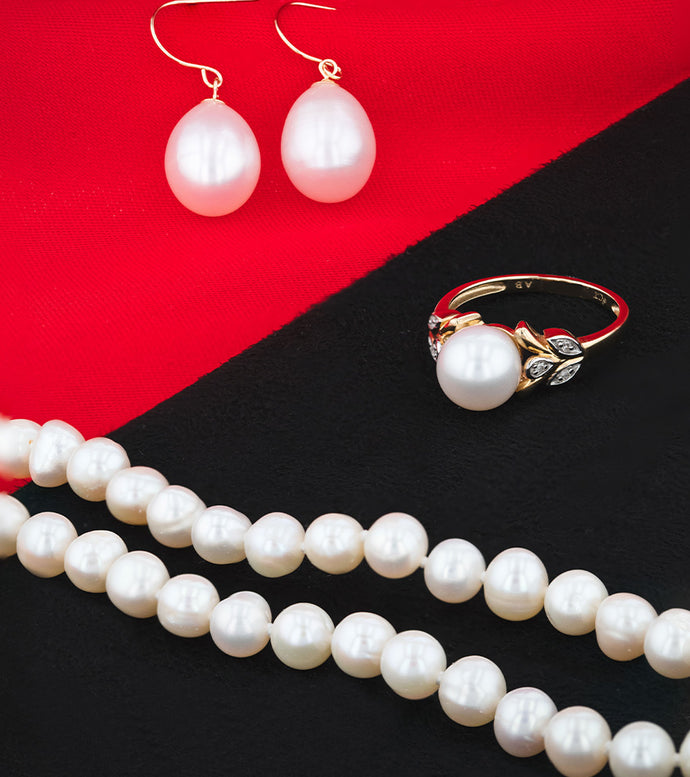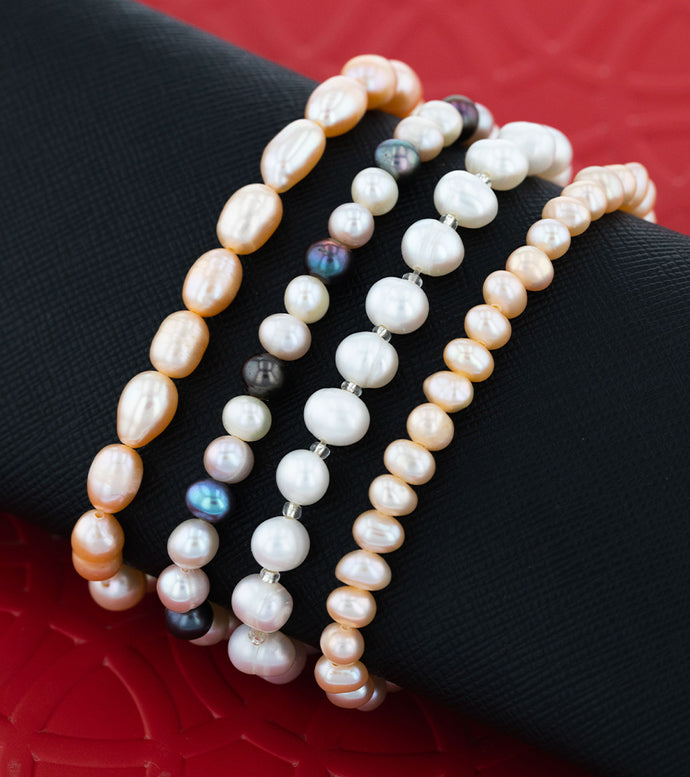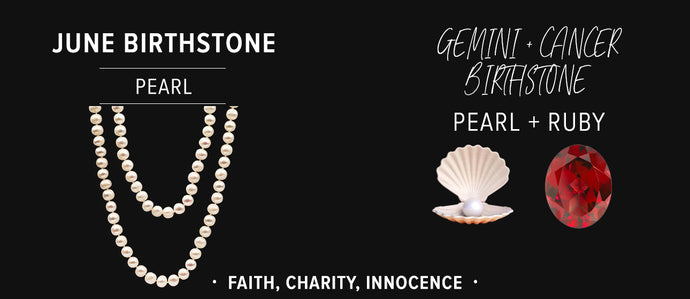June Birthstone
While not technically a stone, the June birthstone is a pearl. Pearls are a hard and glistening object that is embedded within the soft tissue of a clam as well as several other Mollusca sea creatures. Referred to as the ‘Queen of the Gems’, pearls are the only gemstone that forms in a living organism, making them extra special.
Lauded by people all over the world, pearls are an extremely hot ticket item. Particularly when they are in the form of pearl jewellery like pearl necklaces or a string of pearls, an elegant piece that has held pride and place in women’s jewellery boxes for decades.
From its fascinating origins to its curious symbolism, read on to learn all about this birthstone.
OVERVIEW OF THE JUNE BIRTHSTONE:
- Physical compounds & meanings of pearls
- Different types of pearls
- The history of pearls
- Where do pearls come from?
- Our favourite June birthstone jewellery

PHYSICAL COMPOUNDS AND MEANINGS BEHIND PEARLS
Pearls on the market today fall into three categories, natural, cultured and imitation. Composed of calcium carbonate, natural pearls are formed when an irritant-usually a parasite of some kind, works its way into the oyster, mussel or clam. As a defence mechanism, the mollusc will release a fluid known as ‘nacre’ to coat the irritant.
From there, an exquisite pearl will form. Cultured pearls undergo the same process as natural pearls, however, instead of a parasite, a bead or piece of shell known as the ‘Mother of Pearl’ is surgically implanted in the organism. Imitation pearls are formed when a glass bead is dipped into a solution that is usually made from fish scales.
Throughout history, pearls have gained many significant meanings. Many attribute peals to symbolise elegance, romance, virtue, purity, incorruptibility and wisdom. Pearls were also believed to provide protection, while also attracting good luck and wealth. In some cultures, pearls are also seen as a sign of fertility and a long happy life. They were also believed to represent the moon, this is likely due to a pearl’s large white orb appearance that is very reminiscent of the moon.
In many Christian societies, pearls are thought to have formed when Adam and Eve were banished from the Garden of Eden. It is said that when they were banished they began to cry and their tears were turned into pearls. On the contrary, in ancient folklore where pearls were said to harbour medicinal and healing properties that would help ward off evil spirits and negative energy.
In early Chinese civilisation, black pearls were seen as a symbol of wisdom that formed inside of a dragon’s head. The Chinese also believed that these pearls would protect them against fire and dragons, however, the only way they could get their hands on these precious stones if they took on the ferocious beast and won. In Persian culture, pearls were thought to form when a rainbow appeared after a storm. A pearl’s natural imperfections were even believed to be the result of thunder and lightning.
DIFFERENT TYPES OF PEARLS
There are seven types of cultured pearls that jewellers sell today, they are Freshwater pearls, Akoya pearls, Kasumiga pearls and Keshi pearls.
Freshwater Pearls
Developed in Lake Biwa in Japan, freshwater pearls come in many shapes and sizes. Notable for their wide range of colour varieties which can range from pure white and silvery-white to salmon pink, lavender purple, green, blue and even yellow. While white is the most common colour for this type of pearl, the most desirable are the ones that are pastel pink and lavender. These pearls are predominantly produced in China today.
Akoya Pearls
The most recognisable of all the cultured pearl types, Akoya pearls are predominantly round or oval in shape. Usually cultured off the coast of southwestern Japan and China, an Akoya pearl’s colour can range from pinkish white to creamy shades and silvery blue.
Kasumiga Pearls
The most recent type of cultured pearls, Kasumiga pearls are produced from a lake northeast of Tokyo. Coming in a rosy hue that ranges from light to dark pink, Kasumiga pearls are a crossbreed between Japanese and Chinese mussels that form when implanted with round or flat seeds.
Keshi Pearls
Possessing a whimsical charm that is completely unlike the perfectly round and large pearls, Keshi pearls arise spontaneously in the culture of Akoya and South Sea pearls. These small freeform pearls make for exquisite necklaces in colours that range from silvery white to silvery grey.
South Sea Pearls
Primarily cultured in the northern waters of Australia, the Philippines and Indonesia, their rarity and exceptional sizes mean that South Sea pearls are highly sought after. Their colours can range from white and silvery blue to a pale gold or light yellow tone. South Sea pearls can also be black, these pearls are primarily found over a wide area stretching from the Cook Islands, eastward through Tahiti to the Tuamotu Archipelago and the Gambier Islands in French Polynesia.
Tahitian Pearls
Cultured in Tahiti, Tahitian pearls are synonymous with magic and perfection. They are primarily cultured in atolls and lagoons within the South Pacific. The Tahitian pearl oyster is incredibly sensitive to irritants and therefore cannot be raised in crowded areas. Because of this, its pearls can only form in lagoons that meet their unique climatic, biological and ecological needs.
Mabe Pearls
Mabe pearls are half pearls with a beautiful rainbow-coloured iridescent surface. They are cultured from the Mabe pearl oyster which is primarily found in tropical waters off the coast of Southeast Asia and the Japanese islands near Okinawa. Since the beginning of the 20th-century attempts have been made to cultivate round pearls from a Mabe oyster, however, most attempts have been fruitful.

THE HISTORY OF PEARLS
Officially the oldest stone in the world. Pearls have a history that dates back to 2300 BC, where they were presented as gifts to members of the Chinese royal family. Meanwhile, in Ancient Rome, pearls were highly regarded as a status symbol, so much so that Julius Caesar even passed a law prohibiting everyone but the ruling classes to wear the precious spherical stone.
During the dark ages, knights would often wear pearl jewellery on the battlefield, believing that it would keep them safe from harm. According to legend, Cleopatra crushed a pearl into a glass of wine just to prove to her lover Antony that she could put on the most lavish dinner of all time.
The discovery of pearls in Central and South America during the 15th and 16th century led to what is referred to as the ‘pearl age’ due to a spike in demand for precious stones during this time. In Western Europe, pearls were extremely popular among royals and ladies of nobility who wore extremely elaborate pearl earrings, brooches and pearl bracelets.
By the 19th century, the demand for pearls was so high that the world’s supply began to dwindle. This would all change in 1893 when Kokichi Mikimoto, the son of a Japanese noodle maker placed a small shell into an oyster, creating the world’s first cultured pearl.
The world’s fascination with pears continued into the 20th century and peaked during the roaring 20s as long strings of pearls were popular among flapper girls. Fashion designer Coco Chanel would then popularise pearl jewellery in the 1930s with her signature pearl pendants. Later, First Lady Jackie Kennedy and a bevy of Hollywood stars including Audrey Hepburn and Elizabeth Taylor would spearhead this trend throughout the 50s and 60s.

WHERE DO PEARLS COME FROM?
Unlike other gemstones which are retrieved deep within the earth’s crust, pearls are farmed from the ocean which means their location isn’t centric to a particular region. There are, however, several countries that are known for their cultured pearls, these include China, Japan, Australia, the Cook Islands, Indonesia and French Polynesia.
The largest pearl ever found was discovered by a Phillipino fisherman off the coast of Palawan Island in the Philippines. Weighing over 34 kilograms and worth an eye-watering $130 million, the man found the monstrous pearl inside of a giant clam. He then took it home and placed it under his bed for safekeeping as he believed it would bring him good luck. Though, this theory was tested several years ago when the man’s tiny house burnt down. Fortunately, the man and the pearl both survive the blaze.

OUR FAVOURITE PEARL JEWELLERY PICKS
No longer restricted to formal wear, natural and cultured pearls are as at home in the office as they are on the dance floor. Check out our favourite pearl pendants, pearl bangles,pearl rings and more June birthstone jewellery.









































